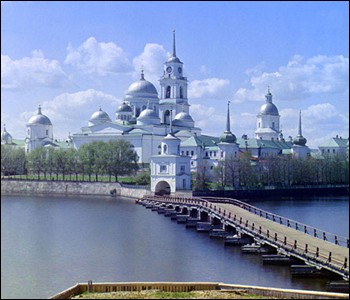|
Colour Photographs Added: January 29 2004 |
|
Okay, check out this picture. How old would you guess it was?  Click for larger version I kid you not. And it's not "colorized". That's an actual color photograph. The other night, I clicked over to K10K for no apparent reason. There was a news story that included the following headline: "Around 1907 Prokudin-Gorskii envisioned and formulated a plan to use the emerging technological advancements that had been made in colour photography to systematically document the Russian Empire." The combination of "1907" and "colour photography" piqued my interest. Even if they used that wacky British spelling. The link led to an online exhibit at the Library of Congress. Long story short: a man by the name of Sergei Mikhailovich Prokudin-Gorskii devised a way to create color photographs using existing photographic methods. Basically, in those days, they didn't have negatives - they used glass plates coated with a gelatin-silver bromide emulsion. The process, however, only produced black and white pictures. Prokudin-Gorskii developed a camera that could take three photographs simultaneously. Each camera had a color filter on the lens - one red, one green, one blue. Each resulting glass plate negative would be in black and white. But when the glass plates were projected simultaneously through lenses with the same filters, the resulting image would be in full-color. Tsar Nicholas II was impressed by the process, and paid for Prokudin-Gorskii to travel around Russia. In the process, Prokudin-Gorskii took over 2000 pictures. After the Russian Revolution, Prokudin-Gorskii collected his negatives and moved to Europe. His heirs later sold the collection to the Library of Congress, who have since recombined many of the negatives to create some shockingly amazing color photographs. What so cool about this to me is that I've always had the feeling that the modern perception of history is based on the photographic record of the period. For example, visualize the 1920's in your head. The Charleston, Coney Island, Charles Lindbergh, the Stock Market Crash. Aren't the pictures you see in black and white? What's even more impressive to me about these is the clarity. When you see color photographs from the 60's and 70's, they're generally fuzzy and faded. But here are these ninety year old pictures that look like they could have been taken yesterday. It sometimes seems hard to imagine that the world looked like it does now so long ago. But, looking at those pictures, you see scenes that could look exactly like that right now in some part of the world. Check out this picture. The guy in that picture was born in 1825! I can't help but imagine what that guy must have seen in his life (and how he lost his arm). Surprisingly, anybody with a copy of Adobe Photoshop can follow the process that the Library of Congress used to recreate the color images. All you have to do is download one of the black and white negatives. (Go here and do a search for "negative" for a few examples.) Just open a new RGB file, go to Channels, select one channel at a time (each color), and paste each black and white negative into the appropriate color channel. (The negatives go top to bottom blue, green, red. It's easiest to use the "higher-res" jpeg that they offer.) The Library of Congress didn't put them all together, granted the vast number of available negatives, so there are a lot available to put together. A lot of times, it's obvious why they didn't recombine them all - many of them have dirt spots or, granted that they're glass plates, have cracks and broken parts. Too much damage on one of the three plates, and the color aspect is lost. And not all of the pictures are very interesting - Prokudin-Gorskii took a lot of pictures of trees and foliage, probably for the benefit of the Tsar. I couldn't help it. I spent a couple of hours putting pictures together. I don't normally geek out on this kind of stuff, but somehow, this seemed really cool to me. |
|
Discuss this on the Comment Board Previous Musing Squirrel Next Musing Blog, Journal, or Waste of Time? |
